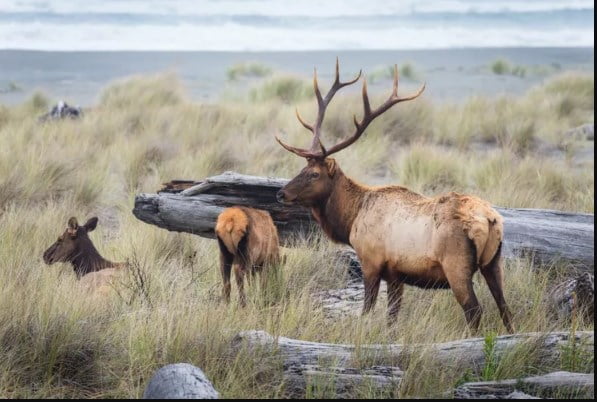Together with Redwood National Park, Jedediah Smith Redwoods State Park, and Del Norte Coast Redwoods State Park, Prairie Creek is managed as part of the Redwood National and State Parks conglomerate. Together, these four parks protect almost half of California’s remaining old-growth redwoods, trees whose average age is 500 to 700 years old. This site is deemed both a World Heritage Site and an International Biosphere Reserve and is certainly worth a visit during any California road trip.
Things to Do
Prairie Creek Redwoods State Park offers a little slice of heaven with its towering redwood trees, sandy beaches, and pristine meadows. At the centerpiece is Elk Prairie, a place where wildlife enthusiasts go to watch the resident elk graze and mate. It’s best visited during mating season (August through October) when you can catch the Roosevelt Elk grazing in the meadows, while the bulls bellow and challenge each other for mating rights. Stop at the picnic area near the visitors center or turn off onto Davison Road where you can view the herd from the turnouts.
Driving the park’s winding roads offers a great way to get the most bang for your buck. The Newtown B. Drury Scenic Parkway takes you by sites like the Big Tree Wayside, a 300-foot towering redwood tree. Bald Hill road, paved only for the first 14 miles, meanders through Lady Bird Johnson Grove, and then onto to Schoolhouse Peak, a great place to have a picnic and take in the views. And Coastal Drive (a narrow route not suited for RVs) takes you out the northern edge of the park, following the bluffs along the coast before descending down into the Klamath River.
The exceptionally beautiful hike through Fern Canyon is a must-do. The path takes you past 50-foot-tall walls of hanging gardens, draped with seven different species of ferns. The environment is so lush and primeval-looking that it was used as a setting in the film “Jurassic Park 2: Lost Worlds.” To get there, take Davison Road from US Hwy 101. It’s an 8-mile drive, partly on dirt roads.

Best Hikes & Trails
This park boasts 74 miles of hiking trails. Before you head out, obtain information on trail conditions by stopping at the visitor’s center or asking a ranger. Seasonal trail closures due to washouts or trail maintenance could cause you to pick another route.
Revelation Trail: This trail is more of a leisurely stroll, offering a 1/4 mile nature walk, complete with interpretive signs that encourage the use of the five senses to experience the Redwoods. Similarly, the Redwoods Access Trail gives visitors with disabilities up-close viewing of the magnificent redwood trees.
Fern Canyon Loop: The Fern Canyon Loop is one of the most heavily trafficked trails in the park. However, this 1.1-mile easy walk offers a look at a majestic display of primal ferns growing on 50-foot tall canyon walls. It’s slow going, as you’ll be stopped in your tracks by the beautiful sights and the rainforest vibe.
Prairie Creek Redwoods Walk: Just a few steps from the visitor’s center, this 5.5-mile trail, suitable for all ability levels, takes you to another world. The trail, surrounded by a “jungle of giants,” meanders past lush ferns and towering trees, and over mossy bridges. The trail connects to several more challenging spurs, should you want to venture further.
James Irvine Trail: This 10.4-mile out-and-back gains 1,404 feet in elevation as it heads towards the coast. Bring water-resistant shoes or closed-toed and heeled sandals so you can navigate the creek crossings and slippery down logs. When you get to the coast, take time to picnic on the beach before heading back.
Where to Camp
Prairie Creek Redwoods State Park has two campgrounds that can accommodate tent camping, trailers up to 24 feet long, and campers and motorhomes up to 27 feet. The park is seldom packed, but making a campsite reservation will assure that you’re not disappointed when you arrive.
Elk Prairie Campground: This campground was built in the 1930s and is just a few steps away from the visitor’s center. It’s open all year round (with limited capacity in the winter), and offers tent sites, RV sites, and a handful of cabins, complete with electricity, heaters, and lights, but no kitchens or bathrooms. The campground has a bathroom and shower building, but pets are not allowed.
Gold Bluffs Beach Campground: This is one of the few places in California where you can camp right next to (but not on) the beach. It boasts 24 tent and RV sites (for campers up to 24 feet long) but has no hookups, and trailers are not permitted. The wind can blow hard here, so plan accordingly if you’re tent camping and pack along some serious tent stakes just in case.
How to Get There
Prairie Creek Redwoods Park is 50 miles north of Eureka, California, and 25 miles south of Crescent City. The main part of the park is off of U.S. Highway 101 and is best accessible by car.
The California Redwood Coast-Humboldt regional airport is located 37 miles south of the park‘s visitor’s center. The closest international airports are in San Francisco and Sacramento, both over a five-hour drive from the park.
Accessibility
This park does a great job of accommodating those with disabilities. The Elk Prairie Creek Campground has several accessible sites with paved parking, accessible campfire rings, and four handicapped-accessible cabins, as well as restrooms and showers. Gold Bluffs has accessible sites, restrooms, and showers, but the path to the restrooms is packed gravel, not paved. Eight trails in the parks are ADA-compliant, including the Redwood Access Trail, which is specifically designed to allow people with physical limitations a chance to experience old-growth trees up close.
Tips for Your Visit
Some of the sites, like Gold Bluffs Campground and Fern Canyon, technically overlap into Redwood National Park. That said, be prepared to buy a national park day-use ticket if you venture to those spots.
When planning your trip, note the seasonal weather. Summer high temperatures range from 40 to 75 degrees Fahrenheit but can be cooler near the coast. Fog is common in both the morning and afternoon. In the winter, the high will be 35 to 55 degrees Fahrenheit during the day. The average rainfall is 60 to 80 inches per year and most of it falls from October through April.
Keep your campsite and picnic area clean and don’t feed the wildlife. This housekeeping rule is essential for protecting the chubby, endangered, sea-going marbled murrelet. This bird—related to the puffin—nests inland in the park’s coastal redwood trees. Food scraps attract hungry crows, ravens, and Stellar’s jays who destroy and eat murrelet eggs and chicks.
Dogs must be on a leash no more than six feet long and must be confined to a tent or a vehicle at night. Except for service animals, pets are not allowed on trails.
Black bears live in and around the park. Practice proper food storage (all campsites have bear-proof food storage boxes) and bear awareness precautions to avoid a dangerous encounter.

